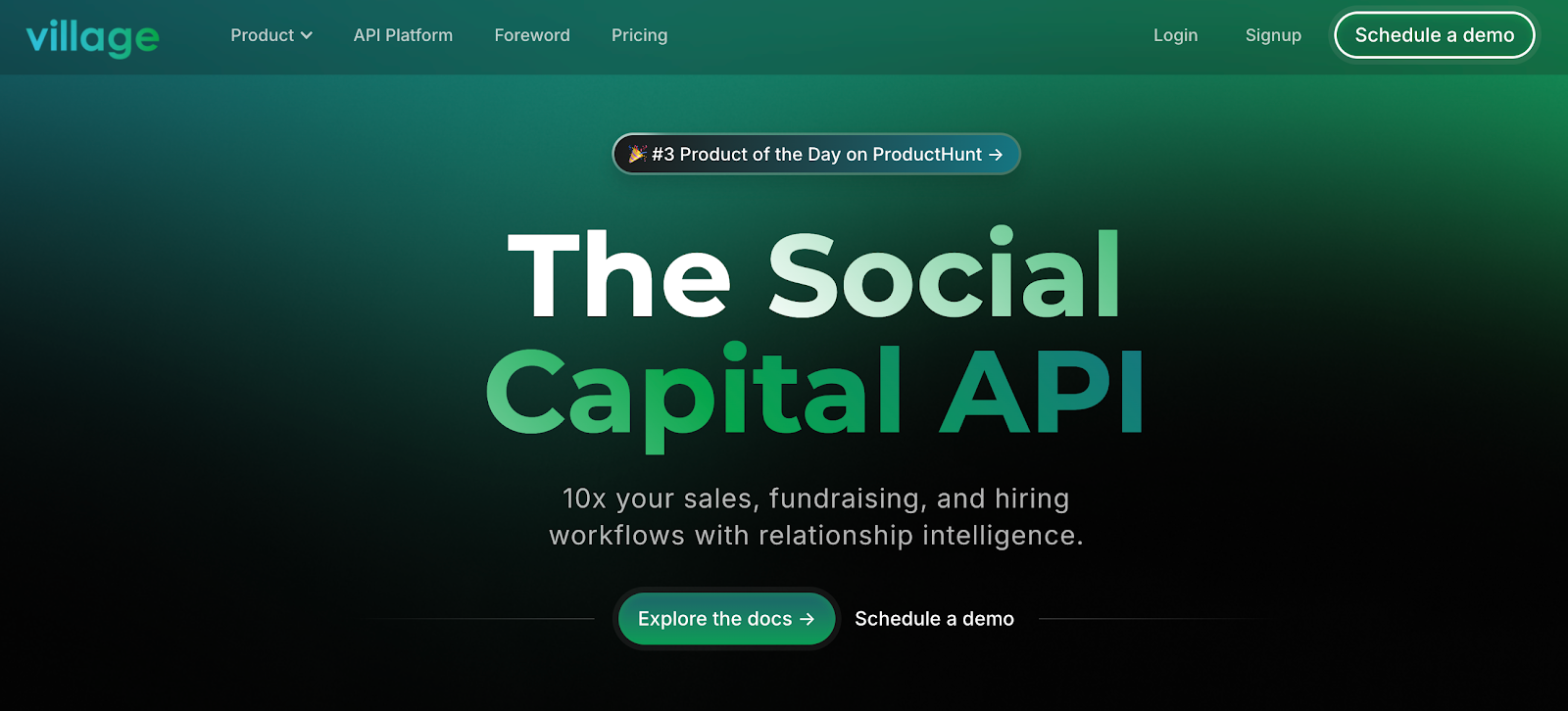Outbound isn’t what it used to be, and blasting cold emails won’t get you far. People ignore cold messages that feel lazy or irrelevant. Buyers expect you to do your homework, so you either meet them with something worth their time, or you’re ignored.
Outbound sales efforts still deliver. You just need sharper targeting, better timing, and messaging that feels like it’s written by a human.
If you’re reaching out, make it count. Today’s best outbound teams are using the outbound sales strategies below to get responses and book serious meetings.
1. Account-Based Marketing
Focus on accounts that match your ideal customer profile. Account-based marketing (ABM) flips the usual outbound approach. Instead of chasing anyone who opens an email, you identify high-value companies first, then plan your outreach around them.
Build your list based on factors like revenue size, industry, tech stack, and team structure. Then, look at recent funding, leadership shifts, product changes, or expansion plans. The more relevant your message, the better your chances of starting sales conversations.
You can start by:
- Shortlisting 30 to 50 companies that match your ideal customer profile (ICP)
- Using sales intelligence tools to surface buying signals and decision-makers
- Building outreach campaigns that reflect what’s happening at each account
ABM supports outbound sales reps by giving their outreach efforts a clear reason to exist. If your outbound sales process doesn’t start with research and relevance, it won’t go far.
2. Advanced Personalization and Lead Segmentation
If your message feels like it could’ve gone to anyone, it probably won’t get read. The best outbound sales strategies are built on relevance. That starts with segmentation.
Group prospects by company size, industry, or role. Add behavioral signals like webinar attendance or pricing page visits. Then shape the messaging to match each segment.
A rep talking to a SaaS founder shouldn't use the same language as one pitching a vice president (VP) at a Fortune 100. Keep it specific, short, and useful.
Track outbound sales metrics like reply rates by segment. Refine what doesn’t convert. This helps your sales team focus their time and lowers customer acquisition cost.
3. Multi-Channel Outreach Sequences
Prospects split their day across inboxes, LinkedIn, and voicemail. If you stick to email, you leave half the market unseen. A multi-channel sequence gives your sales team more chances to start real conversations.
Multi-channel outreach helps your sales reps reach more potential clients without relying on a single tactic. The key is to stay consistent and keep each message relevant.
Here’s an example you can start using:
- Day 1: Send a LinkedIn connection request with a short note referencing a post they shared.
- Day 2: Follow up with an email that connects your offer to that post’s topic.
- Day 4: Make an outbound sales call and mention one specific line from your email.
- Day 6: Comment on one of their LinkedIn posts to stay visible on social media platforms.
- Day 9: Send a second email with a short story about how you helped a similar customer.
Track opens and replies by channel inside your sales tools. When email slows but calls convert, move volume toward outbound sales calls. The goal is to pull potential clients into your sales pipeline on the channel they prefer.
4. Use AI and Automation to Support Your Outreach
Automation helps speed up outbound prospecting, but it won’t fix weak outreach. You still need to sound like a person, not a script.
Use AI to qualify leads based on job titles, tech stacks, and hiring patterns. This helps your sales team focus on prospects who are more likely to convert. You can also identify sales-qualified leads by tracking signals like recent funding or product launches.
AI tools can generate email subject lines or opening lines. Don’t send them as-is. Edit them based on your buyer personas and make sure they match your tone.
Track outbound sales metrics like reply rates, meetings booked, and conversions. These numbers tell you which outbound sales tactics are working and where your messaging falls flat.
You’re not removing the human element. You’re just clearing the busywork so sales reps can focus on closing deals.
5. Use Social Selling to Build Trust Before the Pitch
Before you reach out, give your target audience a reason to recognize your name. Social selling helps your sales reps build familiarity without jumping into a sales pitch too early.
Focus on the platforms your potential clients use. For outbound sales teams, LinkedIn is usually the strongest option. Use it to engage in ways that support your outbound sales efforts without feeling intrusive.
Specific actions to take:
- Comment on posts from people in your target accounts
- Share content that addresses pain points your buyer personas care about
- React to milestones like new product launches or funding announcements
- Send connection requests with short, relevant notes
This activity helps you stand out before you ever call or email. It also lowers the resistance when you initiate your outbound sales calls or campaigns.
6. Use Video to Make Your Outreach More Personal
Video helps your outbound efforts feel personal. When done well, it gives potential customers a reason to pause and hear you out.
Use a simple tool like Loom or Vidyard to record a short video. Keep it under 90 seconds. Speak directly to the viewer. Mention their role, recent news about their company, or a challenge tied to their sales cycle or industry.
Sales reps using personalized video are seeing stronger engagement. Buyers are more likely to respond when your message feels custom to them, and 78% say they want brands to communicate with video.
Video works especially well for outbound sales reps following up after a phone call or email. Add a thumbnail with their name or company logo to increase clicks. Then track who watches the video using your sales tools.
7. Write Follow-Ups That Add Context for the Buyer
Most outbound sales campaigns fail because reps give up too early or repeat the same message. A follow-up should give the person a reason to pay attention.
Share something useful. You could highlight a quick win from an existing customer, link to a recent product update, or mention a shift in their industry. Keep it short and focused on their role or business priorities.
Space your emails out by a few days. Use outbound sales tools to track open rates, clicks, and behavior on your site. These key metrics help you time your next step.
If emails go cold, try a short LinkedIn message or a quick voicemail. Switching channels increases your chances without overwhelming potential customers.
Look at reply rates and booked calls across your outbound sales activities. That data helps your sales team refine outreach and improve outbound sales performance over time.
8. Use Trigger Events to Reach Prospects at the Right Moment
Timing can change how your message is received. When a company hires a new executive, announces funding, or updates its product, it opens a window for outbound outreach that feels relevant.
Set up alerts for your top accounts using LinkedIn Sales Navigator, Google Alerts, or job tracking tools. Watch for events like:
- Executive hires
- Funding announcements
- Product launches
- Job openings in sales or marketing
- Expansions into new markets
Once you find the trigger, reference it directly in your message. Make it short and specific. If a new VP of Sales just joined, ask how they are thinking about outbound sales techniques. If the company launched a new product, ask about their lead generation strategy in that space.
These signals help your sales representatives reach out at the right time, with the right context. They also give structure to your outbound sales activities, so you know when to follow up.
9. Replace Cold Outreach With Warm Introductions
Start by mapping your extended network. A platform like Village pulls in LinkedIn, calendar history, and customer relationship management (CRM) data to reveal hidden paths into target accounts. You can see which sales professionals, advisors, or existing customers already know your prospect.
Use that insight to request double-opt-in intros that respect everyone’s inbox. A brief note explaining why the connection matters is enough. Warm intros often deliver high-quality leads and strengthen customer lifetime value because trust comes built-in.
This method supports lead generation without cold calling and aligns with effective outbound sales strategies that focus on relevance. Track intro acceptance and follow-up outcomes in your CRM system to measure outbound sales success over time.
10. Test, Measure, and Improve Your Outreach Every Quarter
Consistent testing keeps your prospecting and lead generation aligned with what people respond to now.
Change one variable at a time so you can track exactly what improves conversion rates. You might try a shorter subject line, a new first-line hook, or a different follow-up gap. Keep the rest of your approach consistent during each test.
Focus on reply rates, booked meetings, and qualified leads. Share the results with your sales team and marketing team so everyone sees what’s working.
Try a simple test cycle like this:
- Week 1: Shorter email subject lines
- Week 2: New first-line personalization angle
- Week 3: Different call opener question
- Week 4: Adjusted follow-up timing
Review the data at quarter’s end. Adopt the winners, drop the laggards, and move on to the next set of experiments. This steady cycle fuels sales growth and helps you engage potential customers with effective outreach.
Put These Strategies Into Action
You don’t need to apply every tactic at once. Pick two or three strategies that match where your outbound sales efforts feel stuck. If your emails get ignored, focus on personalization or timing. If your response rate is low, test different outreach sequences or channels.
Set clear goals for each round of outreach. Track booked meetings, replies, and conversions. This helps your business development representatives understand where to adjust.
To get started:
- Review your last 10 outbound messages and look for generic phrasing
- Choose one new strategy and apply it to a focused list of accounts
- Set a weekly goal tied to outbound activity
Outbound sales refers to more than just contacting prospects. When done well, the advantages of outbound sales include faster feedback, better message control, and consistent lead flow.
Upgrade Your Outbound Strategy With Relationship-Based Selling

The best outbound teams focus on connection, not volume. That means fewer cold emails and more intentional outreach based on trust and timing.
Village helps you build those connections. It finds warm paths to your prospects using your network—LinkedIn, calendars, and CRM data—and shows you who can introduce you. Instead of chasing cold leads, you engage through people who already know your buyer.
You still own the message, but now you’re starting from a place of familiarity. That alone can improve your reply rates and shorten the time it takes to build trust.
Village gives you:
- Instant visibility into warm paths across your extended network
- A double opt-in system that respects everyone’s time
- A way to scale warm outreach without increasing outbound volume
Someone in your network might already know your next prospect. Use Village to uncover the connection!
FAQs About Outbound Sales Strategies
How to succeed in outbound sales?
You succeed in outbound sales by being intentional with your outreach. This means understanding who your prospect is, why they might care, and when to reach out. Success also comes from consistent follow-ups that offer useful sales data.
What are outbound strategies?
Outbound strategies are methods used to start conversations with people who haven't interacted with your brand yet. These strategies include cold emailing, cold calling, social outreach, and sending personalized videos. The goal is to reach potential buyers who match your target profile but haven't entered your funnel on their own.
What are the KPIs for outbound sales?
Key performance indicators (KPIs) for outbound sales include response rate, number of meetings booked, conversion rate, and outbound revenue generated. You can also track how long it takes to move a lead through each stage of the sales process.
What is the outbound sales model?
The outbound sales model is a direct outreach approach where sales representatives initiate contact with potential customers. This includes cold emails, phone calls, and other direct outreach methods to start conversations and generate leads.








